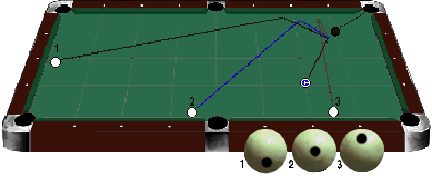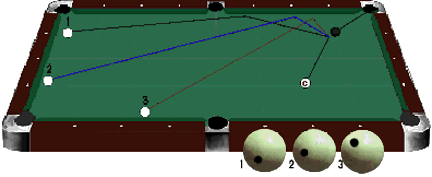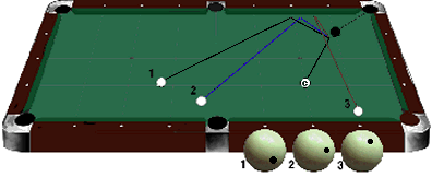Do You Really Need Side Spin To Shoot Well
| by Jim Meador
Many top players suggest that the use of side spin (right or left english) is not critical to shooting good pool. I agree. Most of what can be achieved with side spin can be accomplished with top or bottom, if there is a clear path to the position point. However, knowledge of side spin can offer alternative "paths" to the position desired if the preferred path is blocked.
It is not the spin alone that makes it possible to alter tangents and rebound angles. It is the combination of spin and speed that makes the possibilities infinite. Consider the following:
1) Using top spin will bend a tangent path forward.
2) Bottom will bend the tangent path backward.
3) Shooting hard will close the rebound angle off the rail.
4) Shooting easy will widen the rebound angle off the rail.
By combining the appropriate top or bottom spin with the right speed, the shooter can send the cue ball off the object ball to about any place on the table, assuming interfering balls can be avoided.
(A) No Side Spin

Set up an object ball and the cue ball as shown below. You might want to use loose leaf notebook paper reinforcers to mark the spots. They are easily removed.
Use the hits shown on the larger cue balls (along the edge of the rail) to reach the corresponding numbers on the table.
By using only center, top or bottom hits on the cue ball, most positions on the table can be reached by the cue ball after pocketing the object ball. Keep in mind that the paths can be extended or shortened, and altered altogether with more or less speed and/or spin. If you practice these shots, and do not achieve similar results, make sure you are not cheating the pocket. Also, different cue sticks can produce more or less spin, depending on the condition of the tip. Just pay attention to where you hit the cue, and how the cue ball reacts off the rail in order to understand the dynamics. All strokes are near medium-hard.
(B) Add Outside English to (A)

The shot here is set up just as on table (A). But, notice the hits shown on the cue balls. We have added outside (running) english.
Immediately you will notice that the cue ball travels much faster after leaving the rails, hence the term "running english". Additionally, the rebound angles off the rail are opened up. With the additional speed and wider angles off the rails, it is possible to use bottom left (hit 1) to travel completely and safely around the table.
(C) Add Inside English to (A)

For me, and many others, inside english is like the Knight on a chess board. It is a marvelous weapon but takes longer to master.
Inside english tightens rebound angles off the rail, but since the spin is counter to angle of contact with the rail, more friction is generated, and the added friction slows the rebound speed (the opposite of running english). Because of this dynamic, inside english has extremely important, but less used dynamics (at least by beginners).
Inside english also induces more spin and directional throw on the object ball, which requires more aiming compensations.
So, what's the point?
Well, there are many very strong players who do not use side spin. It allows them to concentrate more on pocketing the object ball, and less on pesky cue ball dynamics.
However, I believe they are strong only in terms of their win/loss record against those who are in the process of learning how to use side spin. In other words, they will win more without side spin, because they take fewer chances. Sooner or latter, avoiding side spin will be a disadvantage against the same players who lost to them, but accepted the losses in order to learn more about the game.
It is possible to be a very strong player, and never use left or right english. But I do not believe it is possible to become a great player without it. Of course, that is only my opinion.
Most Popular
Jackass Shooting Pool
Syndrome
Physics of Pool
Bumper Pool
The Masse'
Snooker
Topless Sharking
Selecting a Cue Stick
Long and Straight
Trick Shots
Aiming
We Recommend







